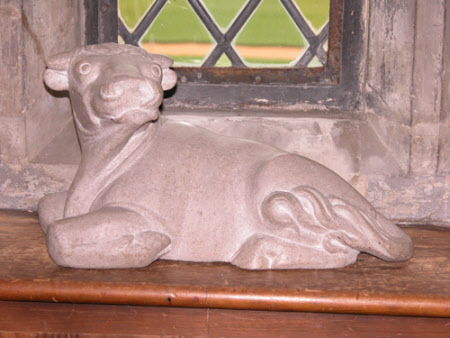Young bull
Alan Durst (1883 - 1970)
Category
Art / Sculpture
Date
1950 (signed and dated)
Materials
Hopton Wood limestone
Measurements
204 x 390 x 178 mm
Place of origin
United Kingdom
Order this imageCollection
Anglesey Abbey, Cambridgeshire
NT 516605
Summary
Hopton Wood limestone, young bull, Alan Durst (1883-1970), 1950, signed and dated 'ALD 1950' on bull’s right foreleg. A sculpture of a recumbent bull, its head turned to left with tail wrapped around its hindquarters.
Full description
Alan Lydiat Durst served in the Royal Marines between 1902-13 and 1914-18; in 1913 he began studies at the Central School of Art, to which he returned in 1920, when he began practising as a sculptor, specialising in the direct carving of stone and wood. Between 1927 and 1951 he was a member of the London Group, founded in 1913 to provide a common ground for progressive painters and sculptors who felt uncomfortable with exhibiting in established venues such as the Royal Academy. Other sculptor members included some of the most avant-garde British sculptors of the first half of the 20th century, such as Frank Dobson, Jacob Epstein and Henri Gaudier-Brzeska. Durst taught wood carving at the Royal College of Art in London between 1925 and 1940, and 1945-48, in 1938 publishing a book Wood Carving (3rd edition 1959). He made many carvings in wood and stone for churches and cathedrals throughout Britain. Durst had a semi-mystical philosophy concerning the practice of carving and especially the use of native materials, which he regarded as intrinsic to the essence of the work of art. Thus, In the preface to the second edition of Wood Carving, he wrote: ‘For an art, to be really alive, must grow in its natural soil; without roots it can have no more continuity or permanence than cut flowers in a vase. The soil in which the sculptor’s art in every country has flourished has been formed principally of the materials of that country./In Britain these materials are stone and timber; and it is in a variety of stones and woods that the true native sculpture of these islands has been made in the past..’ (Wood Carving, 3rd edition, 1959, p. 11) Jeremy Warren, 2019
Provenance
Exhibited Royal Academy of Arts, London, Summer exhibition, 1950, no.1327; acquired by Urban Huttleston Rogers Broughton, 1st Lord Fairhaven (1896-1966); bequeathed 1966to the National Trust by Lord Fairhaven (1896-1966) with the house and the rest of the contents.
Credit line
Anglesey Abbey, The Fairhaven Collection (The National Trust)
Marks and inscriptions
On bull’s right foreleg: ALD 1950
Makers and roles
Alan Durst (1883 - 1970), sculptor
References
The Exhibition of the Royal Academy of Arts, 1950. The one hundred and eighty-second, London 1950, p. 81, no. 1327 Christie, Manson & Woods 1971: The National Trust, Anglesey Abbey, Cambridge. Inventory: Furniture, Textiles, Porcelain, Bronzes, Sculpture and Garden Ornaments’, 1971, p. 150, The Abbey Room
